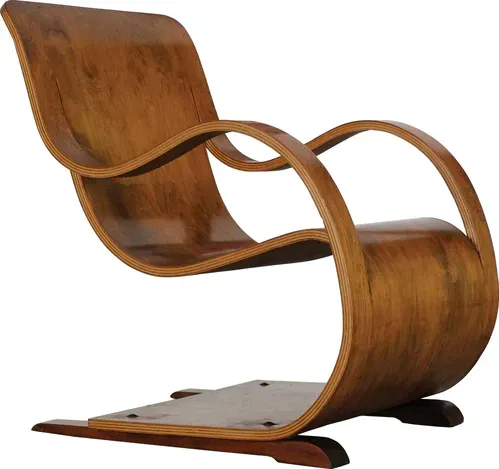Ply-ability
Written by

Ply-ability at Hawke’s Bay Museum & Art Gallery looks at the innovation and change in NZ plywood studio furniture.
On the surface, plywood doesn’t seem the most fascinating of materials, yet there is something so sensuous about the Curvesse chair (1944; pictured right) that those who encounter it for the first time cannot help but be fascinated.
Designed by Garth Chester, the Curvesse is amongst the most iconic works of 20th-century New Zealand furniture. However Chester was not alone in the exploration of plywood as material suitable for creating experimental furniture. It is those themes – a distinct material and a culture of innovation – that Ply-ability sets out to explore.
The exhibition looks at a selection of Garth Chester’s works from the 1940s and 50s including the Curvesse and other major works of his early career. At the same time it doesn’t shy away from the complexities of later works that were shaped directly by contact with the works of American designer Charles Eames.
From there, Ply-ability traces the use of plywood in New Zealand furniture through the following decades. The exhibition features works by other leading designers including the chair Michael Payne designed for Expo 70 in Osaka, Japan; the cabinets designed by influential furniture designer Humphrey Ikin; and the lighting designs of David Trubridge.
Not all of the designers included in Ply-ability are well known, or indeed professionals. One large plywood lounger remains anonymous – something somebody’s dad whipped up in the workshop having fallen under plywood’s spell. Nor are all works completely developed as commercial products. Robbie Greig of the design collective, Candywhistle, is represented by a stool that he fully admits is still in development. It’s works like Greig’s and his contemporaries that curator Lucy Hammonds hopes suggest new directions in the use of plywood by New Zealand designers.
New Zealand really got going with the manufacture of plywood in the 1930s at about the same time modernism arrived as the driving force in design. However today the connection between material and philosophy is less obvious, with a sense – according to Hammonds – that the odds are beginning to stack up against the material. Modernism was driven by a struggle to express new values, with plywood among the materials that articulated that vision. Now, in the 21st century, society faces new challenges requiring equally radical design ideas; it remains to be seen whether plywood will have an ongoing role in shaping the way we create and look at New Zealand furniture.
Recent Hawke’s Bay Museum & Art Gallery exhibitions (like Felix Kelly: A Kiwi at Brideshead and Claire Plug: Look South) have toured to other centres. Ply-ability on the other hand will not be touring, a decision museum director Douglas Lloyd Jenkins is happy with:
“Napier gave Garth Chester his first large commission – the Nicholson chapel chair – so I figure we get to lure visitors here to see just how that particular investment has paid off.”